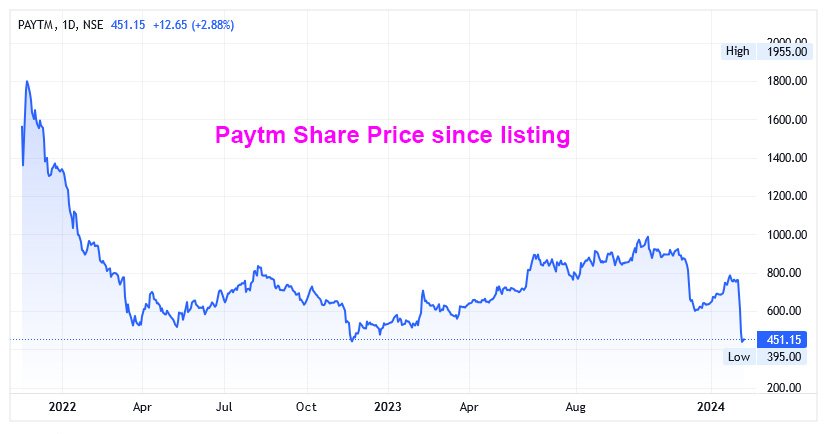Is the stock now an attractive long-term prospect post-correction or does it hint at impending challenges yet to come in the market?
Note: The Paytm Predicament
One 97 Communications Ltd, better known as Paytm, is currently grappling with a significant crisis. The Indian central bank, RBI, has directed the fintech giant to halt further deposits, credit transactions, and top-ups on customer accounts after 29th February 2024. Understandably, this turn of events has not been well-received by the stock market, with the stock plummeting by more than 50% from its 52-week highs.
The pressing question now is whether this correction renders the stock attractive from a long-term investment perspective or if there are more challenges ahead.
While providing a direct answer to these questions may be beyond our purview, we invite you to delve into a previous analysis we conducted when Paytm’s IPO was launched.
Evaluating Paytm’s Investment Worthiness Amidst Turmoil
Upon the lackluster listing of Paytm, my father-in-law lamented, “Poor Vijay Shekhar couldn’t hold back his tears after the poor listing of Paytm,” while we sipped tea. However, it seems there was a misinterpretation. Rather than tears of disappointment, his emotions reflected the joy of realizing his dream.
Setting aside the IPO debacle and ensuing commotion, it’s worth acknowledging the remarkable achievement of a visionary hailing from Aligarh, UP, who toiled tirelessly to establish a Rs 1 lakh crore company.
As a value investor, concerns may arise regarding the company’s profitability and exorbitant valuations. Nonetheless, Vijay Shekhar and his team have indisputably created something that adds substantial value to society, a feat deserving of collective pride.
Returning to the listing, it unquestionably fell short of expectations. A lackluster debut for a stalwart among India’s new-age unicorns does not bode well for investor confidence.
Evaluating Paytm’s Value as an Investment
The recent decline in Paytm’s stock price has raised questions about its valuation and potential as a value investment. As the stock faced a sharp drop of Rs 350 billion in shareholder wealth on its first day, investors are left wondering whether the correction has aligned the stock’s value with its true potential, or if further decline is imminent.
Reassessing Valuation Metrics

Considering the substantial drop in Paytm’s stock price from its IPO level, traditional metrics such as book value per share gain significance. The company’s book value per share is estimated to reach approximately Rs 230-235 post-IPO. Based on this, some investors may see value in the stock if it falls significantly below this level—perhaps around Rs 200 per share.
However, the applicability of book value in valuing tech companies like Paytm is debatable. Unlike traditional businesses, such companies are considered “asset light” and typically trade at a premium to book value.
Challenges in Valuing Paytm
For value investors who traditionally rely on assessing a company’s book value or earnings power, Paytm’s profile presents challenges. The company’s consistent losses over the past three financial years render the earnings power metric ineffective for valuation purposes. Without tangible, positive earnings, evaluating the company’s value becomes increasingly complex.
In the absence of reliable earning data, assessing Paytm’s value based on its earnings capacity remains inconclusive. The unpredictable nature of earnings in the tech industry further complicates this approach.
Seeking Alternative Valuation Approaches
Given the limitations of conventional valuation methods, alternative approaches tailored to assess tech companies’ unique characteristics are necessary. Instead of relying on book value or earnings power, evaluating Paytm’s potential may require innovative metrics that consider the company’s industry dynamics and growth prospects.
Evaluating Paytm: A Deep Dive into Investment Potential
As the influx of value investors dwindles, the benchmark for company evaluation remains rooted in a stable or ascending historical earnings trajectory. Prospective companies are expected to demonstrate profitability over a minimum of five years, a criterion that predicates the consideration of their investment merit. Consequently, enterprises failing to fulfill this prerequisite are swiftly dismissed from further evaluation.
Diverging from the predictability of fixed-coupon bonds, company earnings have the potential to surge perpetually. While current non-profitability does not preclude future profitability, the reconciliation of prospective gains on this basis is critical. Can Paytm’s value proposition be substantiated by anticipating an imminent and substantial surge in profitability?
This juncture, however, marks a critical tipping point, where the purview of investment gradually skews towards speculative terrains, laced with uncertainty. Intuitively, unraveling this enigma demands an exhaustive exploration of the company, a task that mandates an all-encompassing understanding.
However, it’s imperative to question one’s capacity and commitment in pursuing this course. Will you invest the necessary time and effort to unearth that unique insight affirming Paytm as a potential multibagger investment? Perhaps not.
Complicating matters further are the multitudes of astute analysts diligently engaged in a similar pursuit. Outflanking this formidable contingent necessitates a stroke of luck, a factor that becomes increasingly pivotal in shaping investment outcomes.
The established approach of purchasing assets below book value or with a proven track record of profitability affords a degree of security. In fact, a slight premium for consistent growth is considered acceptable. Yet, these hallmarks are conspicuously absent in the case of Paytm.
Undoubtedly, the acquisition of stocks under book value or at modest PE ratios can still yield favorable returns, particularly when diversified across robust businesses in a burgeoning economy like India. Multiplying similar investments in enterprises akin to Paytm, however, heavily hinges on serendipity, subverting the role of skill and discipline in the investment process.
In truth, fortune invariably influences investment outcomes across the board. Nonetheless, an investment landscape where fortuity assumes a subordinate position in the investment narrative is evidently preferable to one where it eclipses prudence and proficiency.
Assessing Paytm’s Investment Potential
The assessment of Paytm’s investment potential introduces a level of uncertainty that may require a stroke of luck to navigate effectively. According to a research report by Macquarie, the ability to monetize Unified Payments Interface (UPI) could be the pivotal factor that reshapes the investment landscape for Paytm. The timing and scale of this potential transformation, however, remain veiled in ambiguity.
The Challenge of Valuation
Presently, reliable methods for valuing the company are elusive, representing a significant challenge for potential investors. The absence of tangible and immediate valuation metrics complicates the assessment of Paytm’s investment prospects.
Complexity of Evaluation
While numerous data points exist to craft a semblance of the company’s value, the complexity lies in the authoritative significance of these metrics. In essence, the ability to assess the true worth of Paytm demands more than merely manipulating abundant data points.
In the words of Einstein, “everything that can be counted does not necessarily count; everything that counts cannot necessarily be counted.” This adage encapsulates the nuanced challenge of comprehensively evaluating Paytm’s investment viability.
In conclusion, while traditional valuation methods may struggle to effectively gauge Paytm’s value, exploring new metrics and perspectives tailored to the tech industry’s dynamics is imperative. As the company continues to navigate its growth trajectory, investors and analysts must adapt their valuation models to accurately capture Paytm’s investment potential.
By incorporating the underlying nuances of Paytm’s business model and industry position, a comprehensive approach to valuation can provide better insights into the company’s long-term investment appeal.
While the path to appraising Paytm’s investment potential presents a degree of uncertainty, understanding the intricate web of contributing factors is essential for informed investment decisions.
Happy Investing!











